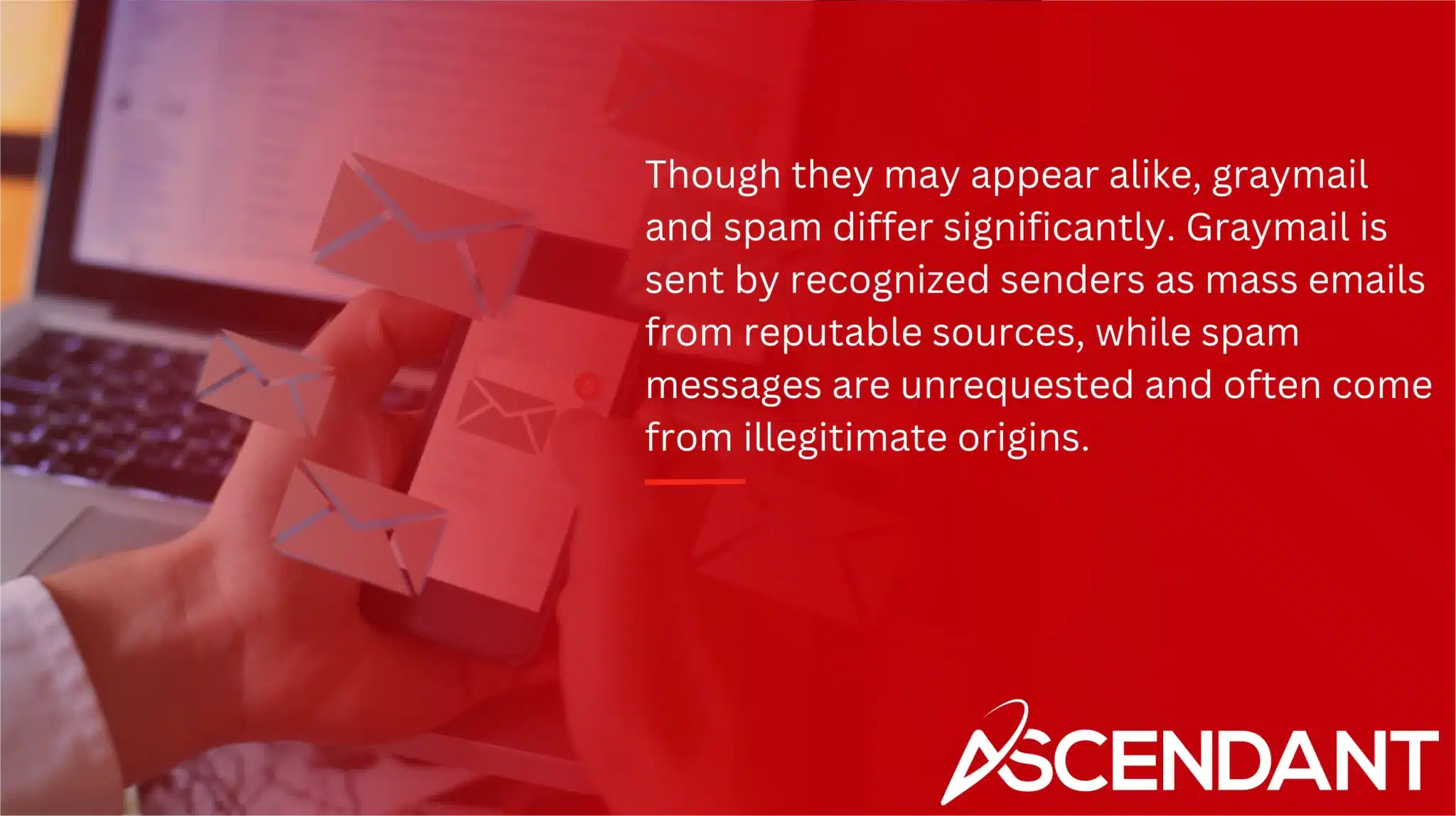Graymail includes unwanted but non-malicious emails from legitimate sources that clutter your inbox, like newsletters and promotions. These emails can be overwhelming and reduce productivity. This article explains graymail and provides strategies to manage it, including filters, preference adjustments, and priority inbox tools.
In This Article:
- Understanding Graymail
- The Impact of Graymail on Email Users
- How Graymail Differs from Spam
- Managing Graymail in Your Inbox
- Best Practices for Preventing Graymail
- The Role of Re-Engagement Campaigns
- Tools and Solutions for Graymail Management
Key Takeaways
- Graymail consists of unwanted but legitimate emails, like newsletters and promotions, that can clutter inboxes and affect productivity.
- Managing graymail effectively involves using filters, adjusting email preferences, and utilizing priority inbox features to streamline important correspondence.
- Businesses can prevent graymail by enhancing user engagement, segmenting email lists, and providing clear unsubscribe options to maintain a positive relationship with subscribers.
Understanding Graymail
Graymail encompasses the onslaught of legitimate, yet often irritating emails such as newsletters, promotional offers, and alerts that we initially agreed to receive but have since become superfluous. Imagine an influx of sale announcements or marketing coupons you never consciously requested – this epitomizes graymail.
Originating from verified senders who secured permission during sign-up processes or transactions, these communications can inundate recipients with a deluge of messages. The sheer number of these unwanted emails could lead to inboxes brimming with clutter, thereby diminishing one’s efficiency considerably. In fact, around 60% of workers cite inbox management as a significant drain on their productive time. Amidst the barrage of spam and messages relegated to the spam folder, it becomes challenging for crucial email correspondences to stand out.
When individuals inadvertently subscribe—or their subscription expectations are misaligned—graymail accumulates even more rapidly, whether through marketing materials like notifications or newsletters. Recognizing graymail is imperative for effective email triage. It aids users in maintaining clarity within their day-to-day digital communication channels without compromising concentration levels.
The Impact of Graymail on Email Users
While graymail is originally requested by users, it can become excessively burdensome, leading to crowded inboxes and reduced efficiency. For example, executives deal with a staggering 230% more graymail than the typical employee does, significantly contributing to their inundated email environments. It’s not an issue exclusive to them. Around one-third of workers spend upwards of an hour each day managing emails that are mostly unnecessary because of the abundance of graymail.
The relentless sifting through such messages can be extremely disruptive and negatively impact productivity levels as well as cause annoyance. As these types of emails often do not engage recipients effectively, they typically experience low interaction rates. The excessive amount of non-essential emails flooding inboxes may adversely influence user engagement measurements and subsequently affect how legitimate correspondence is categorized.
When individuals mislabel necessary communications as spam due to frustration over incessant graymail receipts, this can have adverse effects on critical email reputation ratings—a severe concern for entities dependent on email outreach programs for marketing purposes. Graymail frequently gets deleted or blocked outright by annoyed recipients, which could jeopardize future message delivery likelihoods—and even worse—such mails sometimes conceal harmful phishing attempts that amplify vulnerabilities toward deceptive schemes and fraudulence.
How Graymail Differs from Spam

Though they may appear alike, graymail and spam differ significantly. Graymail is sent by recognized senders as mass emails from reputable sources, while spam messages are unrequested and often come from illegitimate origins. While annoying, graymail usually poses no threat in contrast to potentially harmful spam that might harbor malicious links.
Representing roughly 13% of all email traffic encountered by employees, graymail doesn’t align with conventional definitions of spam. Originating from familiar entities previously deemed useful by the user, these bulk emails stand apart from those crafted by spammers aiming to inflict harm through their messages. It’s vital for users to grasp this distinction in order to manage their inbox efficiently.
Managing Graymail in Your Inbox
To keep your inbox organized and maintain a productive workflow, it’s critical to effectively manage graymail. Utilizing automated filters to sort or redirect these types of messages can be highly beneficial. By consistently updating and refining your email preferences, you’ll be able to curtail the influx of graymail considerably.
Allocating graymail to an isolated folder is instrumental in diminishing distractions and enhancing efficiency. This process involves implementing filters, modifying email settings, and taking advantage of features like priority inboxes which help prioritize important emails. We will delve deeper into these tactics for better management of such messages.
Using Filters Effectively
Implementing email filters that screen for certain sender details, subject content, or unique keywords can substantially aid in controlling graymail. A service like Spambrella offers adjustable filtering capabilities which enable you to distinguish between graymail and outright spam effectively.
These email filters are vital in automatically segregating unwelcome messages from significant correspondence. By establishing these parameters at one point when configuring your email system, the labor needed to handle graymail can be considerably diminished.
Adjusting Email Preferences
Modifying your email preferences serves as a valuable strategy for controlling graymail. Email platforms frequently provide features such as selectable options to dictate the frequency and categories of emails, giving recipients the power to tailor their inbox content. This effectively minimizes the influx of graymail by guaranteeing that only pertinent and sought-after emails make it into your inbox.
Consistently refreshing your email settings not only enhances interaction but also diminishes unnecessary buildup in your mailbox. This arrangement is advantageous for both sender and recipient because it fosters increased rates of engagement while simplifying inboxes.
Leveraging Priority Inbox Features
Incorporating functionalities such as Priority Inbox or inbox tabs from email services empowers users to concentrate on crucial messages and segregate less pertinent graymail. These features have the ability to categorize emails by significance, thereby reducing the presence of graymail in one’s primary inbox view.
By taking advantage of these sorting tools, individuals are able to give precedence to significant communications while diminishing the impact of graymail. This approach enhances the efficiency with which users manage their email inboxes.
Best Practices for Preventing Graymail
To avoid the accumulation of graymail and maintain a tidy inbox, employing several tactics is crucial. Senders of this type of email must adhere to anti-spam regulations by providing recipients with an option to unsubscribe, thus empowering them to take control of their subscription choices. Ensuring that emails are sent exclusively to individuals who have voluntarily signed up and tailoring content for resonance and compelling engagement can help circumvent your messages being labeled as spam.
Implementing a double opt-in process aids in verifying subscriber consent, while strategically dividing your email list according to user interactions enhances the pertinence of distributed content. Keeping subscribers actively interested diminishes the risk of your communications being diverted into junk folders or classified under promotional categories.
Examining these methods Reveals deeper insights into effective practices for managing graymail.
Enhancing User Engagement
Crafting personalized marketing emails is crucial for improving engagement metrics. For example, sending a welcome email to fresh subscribers can markedly elevate customer involvement and loyalty. Tailored promotions and re-engagement initiatives are likewise potent in rejuvenating user interest and enhancing the effectiveness of email campaigns.
When companies supply content that carries substantial value, they succeed in sustaining elevated levels of engagement while ensuring their messages continue to be pertinent. This strategy benefits not just the sender by retaining recipient attention, but also keeps users captivated with what’s being communicated.
Segmenting Your Email List
By categorizing your email list according to how subscribers interact, you enhance the appropriateness of the content delivered. Tailoring content to align with the individual needs and inclinations of each subscriber can notably diminish the amount of graymail encountered.
Allowing recipients to choose both the type of emails they receive and how often they receive them facilitates efficient management of their preferences. Such adaptable choices grant recipients autonomy over their graymail intake, resulting in a tidier inbox experience.
Providing Clear Unsubscribe Options
Maintaining a clear and straightforward unsubscribe process is key to fostering a healthy relationship with your audience. It allows users to opt-out of mailing lists or block specific senders, thus preventing unwanted email messages, known as graymail, from overcrowding their inboxes.
Such clarity not only complies with anti-spam regulations, but also cultivates trust among recipients. By making sure the options to unsubscribe are conspicuous and simple to use, you can help your users avoid aggravation and keep their inboxes tidy and well-managed.
The Role of Re-Engagement Campaigns
Re-engagement campaigns are essential for enhancing email performance by elevating open rates and diminishing bounce rates. They leverage tactics such as behavioral segmentation along with incentives such as discounts or complimentary items to rekindle interest.
Executing a triumphant re-engagement campaign can lead to the activation of customers, thereby boosting their engagement and piquing their interest in your offerings. By focusing on subscribers who have become inactive and presenting them with attractive offers, you can reignite their enthusiasm and bolster the effectiveness of your emails overall.
Tools and Solutions for Graymail Management
A variety of strategies and technologies are at hand for effectively handling graymail. Through the use of Abnormal Security’s email functionality, users can automatically identify and remove graymail without relying on manual filtering methods. Contemporary platforms designed for managing emails excel at intercepting spam and graymail that may evade other systems.
Take INKY as an example. It utilizes sophisticated machine learning techniques along with delivery settings to scrutinize the characteristics of each message. When users signal instances of graymail, INKY leverages this input to refine its ability to recognize such messages more accurately. This system progressively becomes more adept over time through continuous learning from user feedback.
Deploying these instruments significantly reduces the workload on IT personnel by streamlining the process of email management—alleviating their burden in tackling unwanted communication efficiently.
Summary
In essence, dealing with graymail can be quite bothersome. Adopting appropriate tactics can enable efficient management. Grasping the distinction between graymail and spam allows you to put in place effective measures such as employing filters, tweaking your email preferences, and making use of features that prioritize important emails.
To stave off graymail, it’s vital to keep engagement robust by dividing your email list into segments and ensuring there are evident options for recipients to opt out or unsubscribe. Initiatives designed to re-engage users along with advanced tools can also substantially improve how you handle your emails. Following these strategies will help streamline your inbox so that you’re able to concentrate on the most pertinent communications.
 Frequently Asked Questions
Frequently Asked Questions
What is graymail?
Graymail is those pesky emails from senders you know but don’t really want to hear from, filling up your inbox without being harmful.
It’s just clutter that can make email management frustrating!
How does graymail affect productivity?
Graymail can definitely impact your productivity by cluttering your inbox and distracting you, making it harder to focus on important tasks.
Managing those unnecessary emails takes time away from what really matters.
How can I manage graymail effectively?
To manage graymail effectively, set up filters and adjust your email preferences to categorize unwanted newsletters and updates.
This will help you declutter your inbox and focus on what’s important.
What are re-engagement campaigns?
Re-engagement campaigns are all about reigniting interest in your emails and getting your audience excited again. They aim to improve performance and lower bounce rates by reconnecting with subscribers who have become inactive.
Are there tools to help with graymail management?
Absolutely, tools like Abnormal Security and INKY are great for managing graymail by automating removal and detecting unwanted emails intelligently.
They’ll make your inbox much cleaner!

